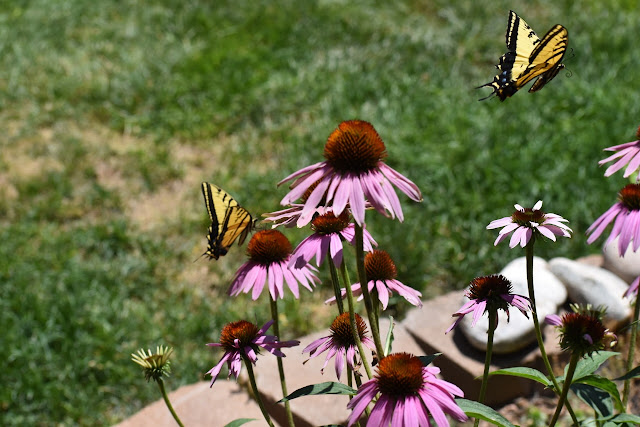Humming birds have been the main attraction that have inspired quite a collection of photos. Using my Nikon with a 75-300mm telephoto lens set on the preset athletic mode, I've been able to photograph them in action. Gradually they have become accustomed to me sitting at the patio table only a few feet away from their hanging feeders.
I make a recipe of sugar water with a ratio of 1/4 cup of refined sugar to a cup of water. I make four cups at a time, keeping in the refrigerator.
The first one showed up mid July, a black throated male. He is a handsome one with a distinct black head and dark throat, but when the sun hits his throat, it is not black, but purple. When I researched this fellow, he really isn't supposed to be in Colorado. He first appeared last year.
I researched the humming bird migration to Colorado where this fellow is listed as one the earliest to arrive and the last to leave late July-August Humming birds will fly 1200 miles from Mexico to reach their destination here and others will migrate over 3,000 miles to Canada.
The males arrive first, staking out their territory to attract a female. They don't made for life, but they seem to raise their two chicks together.
The Rufus is another common Colorado hummer, but we've never seen one here, so imagine our surprise when this one showed up. I knew this female was different by the rust colored underbelly with the white tail feathers. Soon the male appeared.
When the sunlight hit him just right, his brilliant red throat sparkled in the sunlight. So now we had two pairs: the Black Throated, with his drop gray female and the Rufus, with his rusty lady.
She lacks the ruby throat, so she is easy to identify.
This male appears to be a mature male, but we do have a young one that's not fully developed his color that regularly visits the feeders.
Like this young fellow.
This photo really shows the male red plumage.
Along with these four adults, later in the summer we had two young ones zoom through the patio, chasing each other through the trees and branches, sparring at the feeders. At first I thought we had two more competing males; instead, once they stopped they zooming to eat, we were able to identify them as young fledglings from their drab gray feathering. Like most growing kids, they had healthy appetites and did a lot foolish flying. We decided that they were probably Black Chinned, but now I have what seem to be a second Rufus male coming to the feeder. He doesn't like me sitting there, so is he new to the Garden Spot?
Nonetheless the humming birds have been so much fun to watch and photograph.
Bees
Where would we be without the bees? The bumble bees it seems arrived early this season, too, and they were huge. They worked over the cone flowers pretty aggressively.
The honey bees, wasps, and hornets like the waterlilies and have been beeszy with them all summer. There are plenty of blooms to choose from. I especially like to capture these tiny clumsy fliers in flight, which the telephoto allows along with the athletic setting that is a continuous shutter release so that I can get really good action shots then select the best ones out of the series.
Butterflies
The tiger swallowtails are the main butterfly attraction here at the Garden Spot. They dance through the yard on a mission to find food shortly after they have metamorphosed. Sometimes they flit around in pairs, cavorting mid air. They are plentiful here because they will lay their eggs on the leaves of the ash trees, of which we have several. I would guess that we have at least 3 cycles. They don't migrate as the monarchs do, and we expect to see one or two monarchs feed on the butterfly bushes soon.
Thanks for stopping by. I hope you enjoyed your visit.
If you like to visit Ann's Dollhouse Dreams, pop to the latest completed house.
Cheers, Ann























We used to get Swallowtail butterflies in France, but it is rare here to see one. I loved seeing hummingbirds in Canada, such busy little birds!
ReplyDeleteHi Elizabeth. So glad to see you. Glad you enjoined the post.
ReplyDelete